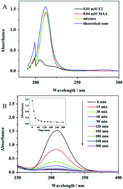An efficient grafting technique for producing molecularly imprinted film via reversible addition–fragmentation chain transfer polymerization†
Abstract
Herein, an efficient approach towards obtaining molecularly imprinted polymer (MIP) film for the detection of 17β-estradiol (E2) with water-compatible properties using a reversible addition–fragmentation chain transfer (RAFT) via photo-initiation is described. 2-Methyl-2-[(dodecylsulfanylthiocarbonyl)sulfanyl]propanoic acid (DDMAT) as the sole control agent in the absence of additional photoinitiators or catalysts was utilized for the synthesis of MIP film. The MIP film was characterized using contact angle measurements, infrared spectroscopy (IR) and scanning electron microscopy (SEM). Analysis of the surface plasmon resonance (SPR) spectra showed that the imprinted film displayed good sensitivity and selectivity to E2 when compared to other competitors and non-imprinted polymer (NIP) film. The response of the E2 ranged from 10−14 to 10−6 mol L−1 with a limit of detection (LOD) of 1.15 × 10−15 mol L−1 (S/N = 3) in PBS buffer (pH 7.4). This sensor showed good reusability and stability, and retained about 84.8% of its original response after 45 days of storage under dry and ambient conditions. Finally, the sensor was applied to determine the concentration of E2 in tap water and underground water samples in the range from 10−13 mol L−1 to 10−7 mol L−1, and the LODs were obtained as 7.4 × 10−15 mol L−1 and 1.12 × 10−14 mol L−1, respectively.



 Please wait while we load your content...
Please wait while we load your content...